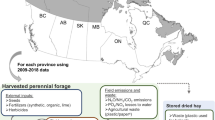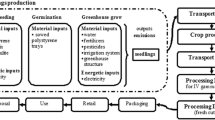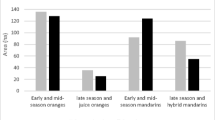Abstract
Purpose
The growing awareness of the importance of biodiversity in agroecosystems in increasing and ensuring the supply of biomass has led to heightened interest from governments and farmers in alternative crops. This article assesses one such alternative crop, cup plant (Silphium perfoliatum L.), in terms of the environmental aspects of cultivation for forage production. Many studies have previously focused on cup plant, but so far, this plant has not been assessed using the life cycle assessment (LCA) method.
Materials and methods
This study compares the environmental load of cup plant with the most commonly grown silage crops in Central European conditions—maize—and with another common forage crop—lucerne using LCA. The system boundaries include all the processes from cradle to farm gate and both mass-based (1 ton of dry matter) and area-based (1 ha of monoculture) functional units were chosen for the purposes of this study. The results cover the impact categories related to the agricultural LCAs, and the ReCiPe Midpoint (H) characterization model was used for the data expression, by using SimaPro 9.0.0.40 software.
Results
This study compares the cultivation of cup plant with the most commonly grown silage crop in Central European conditions—maize—and with another common forage crop—lucerne. The paper shows the potential of cup plant to replace conventional silage (maize and lucerne silage mix) with certain environmental savings in selected impact categories, and importantly, while still maintaining the same performance levels in dairy farming as with conventional silage, as already reported in previous publications. For the Czech Republic alone, this would, in practice, mean replacing up to 50,000 ha of silage maize and reducing the environmental load by about tens of percent or more within the various impact categories and years of cultivation.
Conclusion
Cup plant can replace the yield and quality of silage maize, represents a lower environmental load per unit of production and unit of area and generally carries many other benefits. Thus, cup plant is a recommendable option for dairy farming. Given the recent experience and knowledge of the issue, the cup plant can be considered an effective alternative to conventional silage.



Similar content being viewed by others
References
Agronormativy (2015) Normativy pro zemědělskou a potravinářskou výrobu: AGroConsult. http://www.agronormativy.cz/. Accessed 5 April 2019
Albrecht KA, Goldstein W (1997) Silphium perfoliatum: A North American prairie plant with potential as a forage crop. In Conference June 8–19 Conference Year, Winnipeg 167–168
Albrecht KA, Han KJ, Combs DK (2017) Silphium perfoliatum L. silage as alterative to lucerne and maize silage in dairy cow rations. Grassland resources for extensive farming systems in marginal lands: major drivers and future scenarios 22(1): 500–502
Aurbacher J, Benke M, Formowitz B, Glauert T, Heiermann M, Herrmann C, Idler C, Kornatz P, Nehring A, Rieckmann C, Rieckmann G (2012) Energiepflanzen für Biogasanlagen (Broschüre No. 553). Fachagentur Nachwachsende Rohstoffe eV: Rostock, Germany, 1–84
Bacenetti J, Negri M, Fiala M, González-García S (2013) Anaerobic digestion of different feedstocks: impact on energetic and environmental balances of biogas process. Sci Total Environ 463:541–551
Bauböck R, Karpenstein-Machan M, Kappas M (2014) Computing the biomass potentials for maize and two alternative energy crops, triticale and cup plant (Silphium perfoliatum L.), with the crop model BioSTAR in the region of Hannover (Germany). Environ Sci Eur 26(1):19
Bellarby J, Foereid B, Hastings A (2008) Cool farming: climate impacts of agriculture and mitigation potential. Scotland, Aberdeen
Bernas J, Konvalina P, Brom J, Moudrý J Jr, Veselá T, Bucur D, Dirja M, Shim S (2019a) Agrotechnology as key factor in effective use of water on arable land. In Assessment and Protection of Water Resources in the Czech Republic, Springer, Cham
Bernas J, Moudrý J Jr, Kopecký M, Konvalina P, Štěrba Z (2019b) Szarvasi-1 and its potential to become a substitute for maize which is grown for the purposes of biogas plants in the Czech Republic. Agronomy 9(2):98
Bessou C, Basset-Mens C, Latunussa C, Vélu A, Heitz H, Vannière H, Caliman JP (2016) Partial modelling of the perennial crop cycle misleads LCA results in two contrasted case studies. The Int J Life Cycle Assess 21(3):297–310
Bessou C, Basset-Mens C, Tran T, Benoist A (2013) LCA applied to perennial cropping systems: a review focused on the farm stage. Int J Life Cycle Assess 18(2):340–361
Bufe C, Korevaar H (2018) Evaluation of additional crops for Dutch list of ecological focus area: evaluation of Miscanthus, Silphium perfoliatum, fallow sown in with melliferous plants and sunflowers in seed mixtures for catch crops. Wageningen Research Foundation (WR) business unit Agrosystems Research No 793
Burke M, Emerick K (2016) Adaptation to climate change: evidence from US agriculture. Am Econ J- Econ Policy 8(3):106–140
Campbell BM, Thornton P, Zougmoré R, Van Asten P, Lipper L (2014) Sustainable intensification: what is its role in climate smart agriculture? Current Opinion in Environmental Sustainability 8:39–43
Cattani M, Guzzo N, Mantovani R, Bailoni L (2017) Effects of total replacement of corn silage with sorghum silage on milk yield, composition, and quality. J Anim Sci Biotechnol 8(1):15
CHI (Czech Hydrometeorological Institute) (2020) http://portal.chmi.cz/. Accessed 14 January 2020
Chimento C, Almagro M, Amaducci S (2016) Carbon sequestration potential in perennial bioenergy crops: the importance of organic matter inputs and its physical protection. Gcb Bioenergy 8(1):111–121
CZSO (The Czech Statistical Office) (2020) Prague: Integrated operational program, Uropean Union. https://www.czso.cz/csu/czso/home. Accessed 17 July 2019
De Klein C, Novoa RS, Ogle S, Smith KA, Rochette P, Wirth TC, McConkey BG, Mosier A, Rypdal K, Walsh M, Williams SA (2006) N2O emissions from managed soils and CO2 emissions from lime and urea application. IPCC guidelines for National greenhouse gas inventories prepared by the National greenhouse gas inventories programme 4:1–54
De Wit M, Faaij A (2010) European biomass resource potential and costs. Biomass Bioenerg 34(2):188–202
Dijkman TJ, Basset-Mens C, Antón A, Núñez M (2018) LCA of food and agriculture. Life Cycle Assessment. Springer, Cham, pp 723–754
Dressler D, Loewen A, Nelles M (2012) Life cycle assessment of the supply and use of bioenergy: impact of regional factors on biogas production. Int J Life Cycle Assess 17(9):1104–1115
Durlinger B, Koukouna E, Broekema R, Van Paassen M, Scholten J (2017) Agri-footprint 4.0
Ericsson K, Rosenqvist H, Nilsson LJ (2009) Energy crop production costs in the EU. Biomass Bioenerg 33(11):1577–1586
Escobar N, Ramírez-Sanz C, Chueca P, Moltó E, Sanjuan N (2017) Multiyear life cycle assessment of switchgrass (Panicum virgatum L.) production in the Mediterranean region of Spain: a comparative case study. Biomass Bioenergy 107:74–85
Exnerova Z, Beranova J (2017) Agriculture (CRF sector 3). In: Krtkova E (ed) National Greenhouse Gas Inventory Report of The Czech Republic (reported inventories 1990–2015), 1st edn. Prague, Czech Republic, Czech Hydrometeorological Institute, pp 225–252
Gansberger M, Montgomery LF, Liebhard P (2015) Botanical characteristics, crop management and potential of Silphium perfoliatum L. as a renewable resource for biogas production: a review. Ind Crop Prod 63:362–372
Gansberger M, Stüger HP, Weinhappel M, Moder K, Liebhard P, von Gehren P, Mayr J, Ratzenböck A (2017) Germination characteristic of Silphium perfoliatum L. seeds. Die Bodenkultur: J Land Management Food Environ 68(2):73–79
Gentil C, Basset-Mens C, Manteaux S, Mottes C, Maillard E, Biard Y, Fantke P (2020) Coupling pesticide emission and toxicity characterization models for LCA: application to open-field tomato production in Martinique. J Clean Prod 277:124099
Ghabbour EA, Davies G, Misiewicz T, Alami RA, Askounis EM, Cuozzo NP, Filice AJ, Haskell JM, Moy AK, Roach AC, Shade J (2017) National comparison of the total and sequestered organic matter contents of conventional and organic farm soils. Adv Agron 146:1–35
Goedkoop M, Heijungs R, Huijbregts M, De Schryver AM, Struijs J, Van Zelm R (2009) ReCiPe. A Life Cycle Impact Assessment Method Which Comprises Harmonised Category Indicators At the Midpoint and the Endpoint Level; Report I: Characterisation.
Haag NL, Nägele HJ, Reiss K, Biertümpfel A, Oechsner H (2015) Methane formation potential of cup plant (Silphium perfoliatum). Biomass Bioenerg 75:126–133
Hakl J, Fuksa P, Konečná J, Pacek L, Tlustoš P (2014) Effect of applied cultivation technology and environmental conditions on lucerne farm yield in the Central Europe. Plant Soil Environ 60(10):475–480
Hasler K, Bröring S, Omta SWF, Olfs HW (2015) Life cycle assessment (LCA) of different fertilizer product types. Eur J Agron 69:41–51
Herrero M, Henderson B, Havlík P, Thornton PK, Conant RT, Smith P, Wirsenius S, Hristov AN, Gerber P, Gill M, Butterbach-Bahl K (2016) Greenhouse gas mitigation potentials in the livestock sector. Nat Clim Chang 6(5):452
IPCC (2006) IPCC guidelines for national greenhouse gas inventories. In Eggleston HS, Buendia L, Miwa K, Ngara T, Tanabe K (eds) The national greenhouse gas inventories programme, IGES, Japan
IPCC (2007) Summary for Policymakers. In Solomon SD, Qin M, Manning Z, Chen M, Marquis KB, Averyt M, Tignor, Miller HL (eds) Climate change 2007: the physical science basis. Contribution of working group I to the fourth assessment report of the intergovernmental panel on climate change, Cambridge University Press, Cambridge, United Kingdom and New York, NY, USA, p 18
ISO 14040 (2006a) Environmental management–Life cycle assessment–Principles and framework. International Organization for Standardization: Geneva, Switzerland
ISO 14044 (2006b) Environmental management–Life cycle assessment–Requirements and guidelines; International Organization for Standardization: Geneva, Switzerland
Kavka M, Beneš V, Brant V (2006) Normativy Zemědělských Výrobních Technologií. Praha, Czech Republic, Institute of Agriculture Economics and Information
Klímek P, Meinlschmidt P, Wimmer R, Plinke B, Schirp A (2016) Using sunflower (Helianthus annuus L.), topinambour (Helianthus tuberosus L.) and cup-plant (Silphium perfoliatum L.) stalks as alternative raw materials for particleboards. Ind Crop Prod 92:157–164
Koeppe MK, Hirata CM, Brown HM, Kenyon WH, O’Keefe DP, Lau SC, Zimmerman WT, Green JM (2000) Basis of selectivity of the herbicide rimsulfuron in maize. Pestic Biochem Physiol 66(3):170–181
Kowalski R, Kędzia B (2007) Antibacterial activity of Silphium perfoliatum. Extracts Pharm Biol 45(6):494–500
Kowalski R, Wolski T (2005) The chemical composition of essential oils of Silphium perfoliatum L. Flavour Fragrance J 20(3):306–310
Lewandowski I, Scurlock JM, Lindvall E, Christou M (2003) The development and current status of perennial rhizomatous grasses as energy crops in the US and Europe. Biomass Bioenerg 25(4):335–361
Majtkowski W, Piłat J, Szulc PM (2009) Prospects of cultivation and utilization of Silphium perfoliatum L. in Poland. Biuletyn Instytutu Hodowli i Aklimatyzacji Roślin 251:283–291
Mast B, Lemmer A, Oechsner H, Reinhardt-Hanisch A, Claupein W, Graeff-Hönninger S (2014) Methane yield potential of novel perennial biogas crops influenced by harvest date. Ind Crop Prod 58:194–203
Matthews J, Beringen R, Huijbregts MAJ, Van der Mheen HJ, Odé B, Trindade L, Van Valkenburg JLCH, Velde G, Leuven RSEW (2015) Horizon scanning and environmental risk analyses of non-native biomass crops in the Netherlands. Radboud University Nijmegen, The Netherlands
Moudrý J, Bernas J, Konvalina P, Ujj A, Manolov I, Stoeva A, Rembiałkowska E, Stalenga J, Toncea I, Fitiu A, Bucur D (2018) Agroecology development in Eastern Europe—cases in Czech Republic, Bulgaria, Hungary, Poland, Romania, and Slovakia. Sustainability 10(5):1311
Nemecek T, Kägi T (2007) Life cycle inventories of Swiss and European agricultural production systems. Final report ecoinvent V2.0 No. 15a. Agroscope Reckenholz-Taenikon Research Station ART, Swiss Centre for Life Cycle Inventories, Zürich and Dübendorf, Switzerland, retrieved from: www.econivent.ch
Neugschwandtner RW, Liebhard P, Kaul HP, Wagentristl H (2014) Soil chemical properties as affected by tillage and crop rotation in a long-term field experiment. Plant Soil Environ 60(2):57–62
Novotný I, Žížala D, Kapička J, Beitlerová H, Mistr M, Kristenová H, Papaj V (2016) Adjusting the CPmax factor in the Universal Soil Loss Equation (USLE): areas in need of soil erosion protection in the Czech Republic. J Maps 12(sup1):58–62
Pan G, Ouyang Z, Luo Q, Yu Q, Wang J (2011) Water use patterns of forage cultivars in the North China Plain. Int J Plant Prod 1:181–194
Piłat J, Majtkowski W, Majtkowska G, Mikołajczak J, Góralska A (2007) The usefulness for ensiling of chosen plant forms of species of Silphium genus. J Cent Eur Agr 8(3):363–368
Poláková J, Janků J, Nocarová M (2018) Soil erosion, regulatory aspects and farmer responsibility: assessing cadastral data. Acta Agric Scand Sect B-Soil Plant Sci 68(8):709–718
Pretty J, Bharucha ZP (2014) Sustainable intensification in agricultural systems. Ann Bot 114(8):1571–1596
Sarkar D, Kar SK, Chattopadhyay A, Rakshit A, Tripathi VK, Dubey PK, Abhilash PC (2020) Low input sustainable agriculture: a viable climate-smart option for boosting food production in a warming world. Ecol Indic 115:106412
Sinisterra-Solís NK, Sanjuán N, Estruch V, Clemente G (2020) Assessing the environmental impact of Spanish vineyards in Utiel-Requena PDO: the influence of farm management and on-field emission modelling. J Environ Manage 262:110325
Sithole NJ, Magwaza LS, Mafongoya PL, Thibaud GR (2018) Long-term impact of no-till conservation agriculture on abundance and order diversity of soil macrofauna in continuous maize monocropping system. Acta Agric Scand Sect B-Soil Plant Sci 68(3):220–229
Smith P, Martino D, Cai Z, Gwary D, Janzen H, Kumar P, McCarl B, Ogle S, O’Mara F, Rice C, Scholes B (2007) Greenhouse gas mitigation in agriculture. Philos Trans R Soc B-Biol Sci 363(1492):789–813
Stanford G (1990) Silphium perfoliatum (cup-plant) as a new forage. Proceedings of the Twelfth North American Prairie Conference, Cedar Falls, IA 1:33–37
Țîței V (2014) Biological peculiarities of cup plant (Silphium perfoliatum L.) and utilization possibilities in the Republic of Moldova. Lucrări Științifice UASMV Seria Agronomie 57(1):289–293
Ţîţei V, Teleuţă A, Muntean A (2013) The perspective of cultivation and utilization of the species Silphium Perfoliatum L. and Helianthus Tuberosus L. in Moldova. Bulletin UASMV Seria Agriculture 70(1):160–166
Usťak S (2012) Possibilities of cultivation of cup-plant Silphium perfoliatum L. for biogas production. Crop Research Institute, v.v.i., Prague
Usťak S, Munoz J (2018) Cup-plant potential for biogas production compared to reference maize in relation to the balance needs of nutrients and some microelements for their cultivation. J Environ Manage 228:260–266
Vacek V, Repka R (1992) Concise results of the experiment with Silphium perfoliatum L. Czechoslovak Plant Genet Resour, annual report 1991
Van Tassel DL, Albrecht KA, Bever JD, Boe AA, Brandvain Y, Crews TE, Gansberger M, Gerstberger P, González-Paleo L, Hulke BS, Kane NC (2017) Accelerating Silphium domestication: an opportunity to develop new crop ideotypes and breeding strategies informed by multiple disciplines. Crop Sci 57(3):1274–1284
Vašíčková J, Hvězdová M, Kosubová P, Hofman J (2019) Ecological risk assessment of pesticide residues in arable soils of the Czech Republic. Chemosphere 216:479–487
Vinyes E, Gasol CM, Asin L, Alegre S, Muñoz P (2015) Life cycle assessment of multiyear peach production. J Clean Prod 104:68–79
Vogel E, Deumlich D, Kaupenjohann M (2016) Bioenergy maize and soil erosion—risk assessment and erosion control concepts. Geoderma 261:80–92
von Cossel M, Amarysti C, Wilhelm H, Priya N, Winkler B, Hoerner L (2020) The replacement of maize (Zea mays L.) by cup plant (Silphium perfoliatum L.) as biogas substrate and its implications for the energy and material flows of a large biogas plant. Biofuel Bioprod Biorefin 14(2):152–179
Webb J, Sørensen P, Velthof G, Amon B, Pinto M, Rodhe L, Salomon E, Hutchings N, Burczyk P, Reid J (2013) An assessment of the variation of manure nitrogen efficiency throughout Europe and an appraisal of means to increase manure-N efficiency. Adv Agron 119:371–442
Wernet G, Bauer C, Steubing B, Reinhard J, Moreno-Ruiz E, Weidema B (2016) The ecoinvent database version 3 (part I): overview and methodology. The International Journal of Life Cycle Assessment, [online] 21(9), pp.1218–1230. Available at: <http://link.springer.com/10.1007/s11367-016-1087-8> [Accessed 21 10 2020].
World Health Organization (WHO) (2011) ISBN 978 92 4 154815 1. Guidel Drink Water Qual 398
Wrobel M, Frączek J, Francik S, Slipek Z, Mudryk K (2013) Influence of degree of fragmentation on chosen quality parameters of briquette made from biomass of cup plant Silphium perfoliatum L. Eng Rural Dev, Jelgava, Latvia 1:653–657
Acknowledgements
The authors would like to thank Christopher Steer (University of South Bohemia in České Budějovice-Faculty of Science, Language Department) for his proofreading of the paper and to Pedro Gerstberger (University of Bayreuth, Department of Plant Ecology, Bayreuth, Bavaria, Germany) for the material support. We finally want to warmly thank the anonymous reviewers for their comments, which improved the quality of the paper.
Funding
The research was financially supported by the University of South Bohemia in České Budějovice (project No. GAJU 045/2019/Z).
Author information
Authors and Affiliations
Contributions
Jaroslav Bernas: conceptualization, data collection, methodology, software, validation, formal analysis, investigation, resources, writing—original draft preparation, writing—review and editing, visualization, supervision; Tereza Bernasová: writing—original draft preparation, writing—review and editing, visualization, investigation; Pedro Gerstberger: material support; Jan Moudrý: material support; Petr Konvalina: supervision; Jan. Moudrý Jr.: supervision.
Corresponding author
Additional information
Communicated by Thomas Jan Nemecek.
Publisher’s Note
Springer Nature remains neutral with regard to jurisdictional claims in published maps and institutional affiliations.
Rights and permissions
About this article
Cite this article
Bernas, J., Bernasová, T., Gerstberger, P. et al. Cup plant, an alternative to conventional silage from a LCA perspective. Int J Life Cycle Assess 26, 311–326 (2021). https://doi.org/10.1007/s11367-020-01858-x
Received:
Accepted:
Published:
Issue Date:
DOI: https://doi.org/10.1007/s11367-020-01858-x




